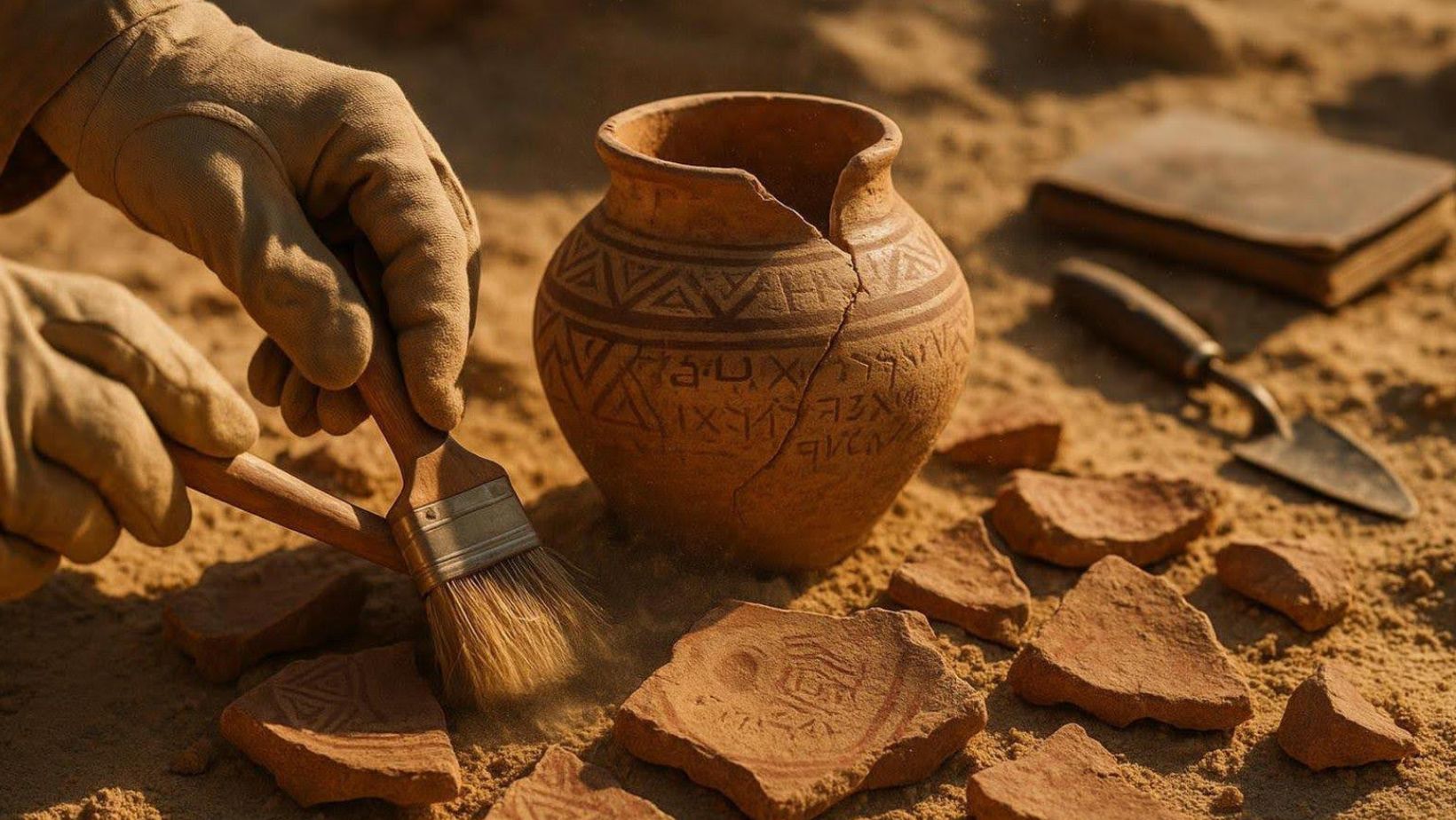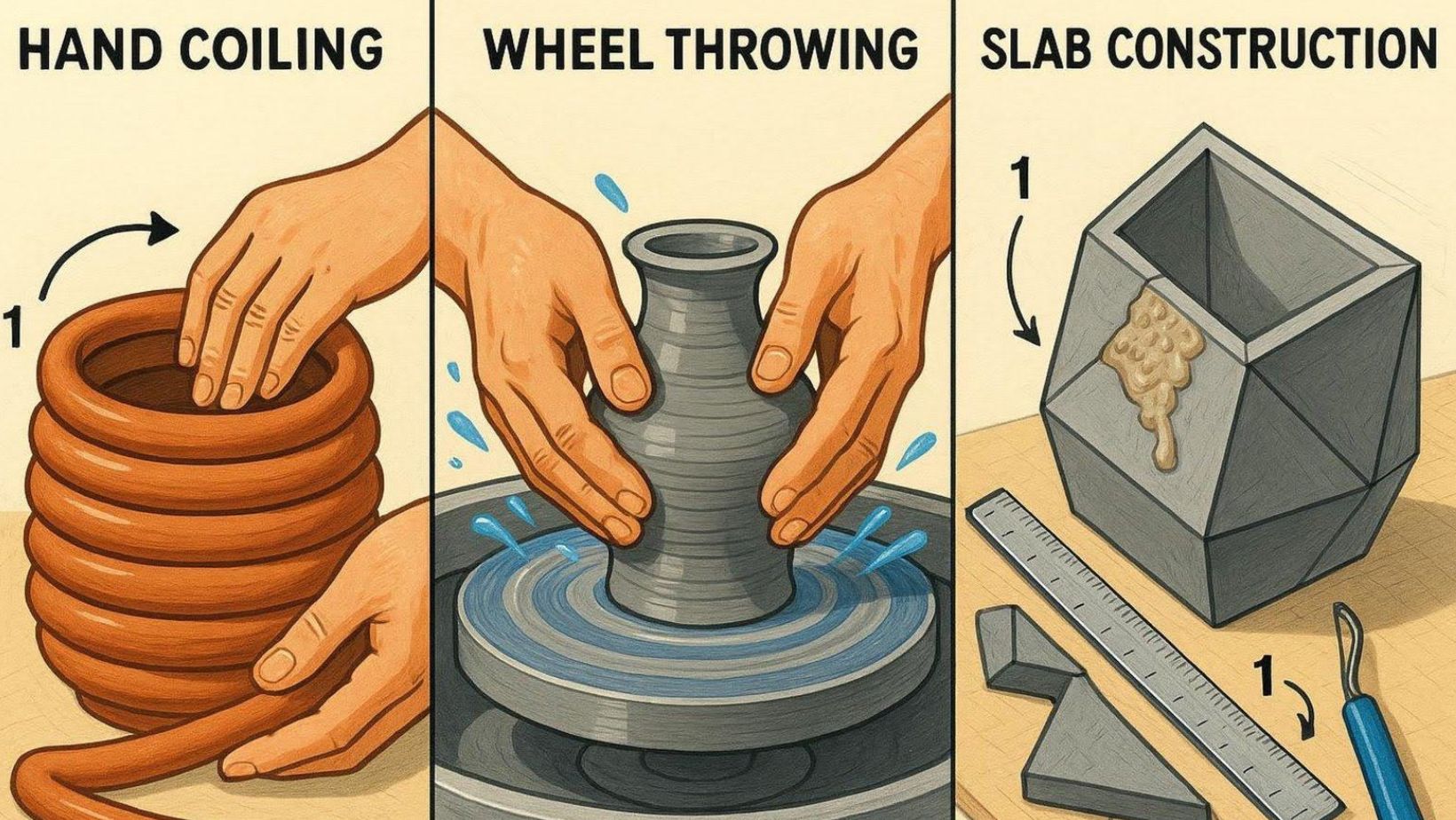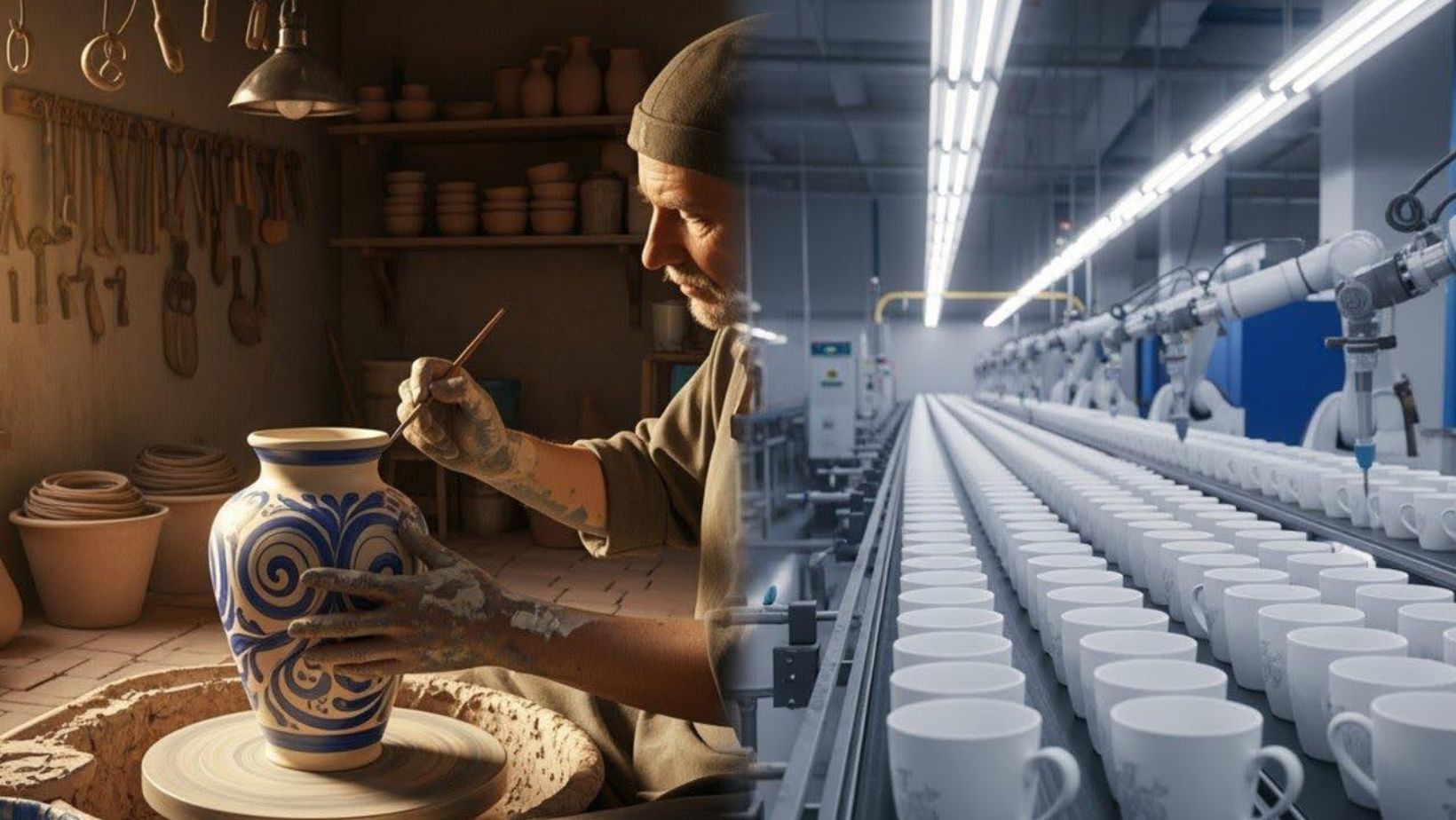Local pottery is much more than basic everyday items. It’s a lively way that cultural traditions stay alive and strong. Each handmade piece is like a small piece of history, showing the story of its region, its people, and their deep connection to the land. When potters work with clay, they turn simple materials into items that show generations of tradition-passing down skills, symbols, and values.
You can see this rich background in the careful decorations of Chinese porcelain, the rustic look of Native American pottery, and the recognizable patterns of Boleslawiec Polish pottery. Each style is shaped by its unique cultural background.
Local pottery has the special power to connect the old with the new, making sure that traditional techniques and stories don’t get lost, even as the world changes quickly. It shows the creativity and talent of humans, turning what was once a simple need into a strong sense of cultural identity.
This article looks at how local pottery keeps culture alive by looking at its history, the unique ways it’s made, the communities involved, and the problems it faces today.
What Makes Local Pottery Special?
Local pottery stands out because of the mix of regional details, history, and each artist’s personal touch. The real heart of any pottery style comes from its link to the land. The clay itself changes in color and texture depending on where it’s found, which makes every area’s pottery a little different.
These differences aren’t just in the materials; each region also uses methods that work best with their local clays and tools.
Local pottery also carries the spirit of its community. Many potteries have patterns, shapes, or pictures that show local stories, beliefs, or daily life. For example, Native American pottery often has designs representing spiritual beliefs, while African ceramics feature bold shapes that tell stories about community. These designs say a lot about where they come from and aren’t just for looks-they’re ways of writing history in clay.
Why Is Pottery Important to Cultural Identity?
Pottery is important for culture because it’s a real, lasting record of our civilizations. Pottery started as a way to store food and water as far back as 29,000 BCE, but it quickly became a way to show art and culture. Each place has its own way of making and decorating pottery, shaped by its own materials and ways of working.

For example, Greek pottery might show legends, while Native American ceramics use symbols with deep meaning. By looking at what a culture makes with pottery, you can learn about their day-to-day life, creativity, and even how their society was organized. Pottery saves stories for thousands of years-making it a silent record keeper of humanity.
Pottery’s Role in History
Pottery is one of the oldest crafts and can be found in almost every society’s history. For over 20,000 years, it’s helped meet basic needs like storing and cooking food. But it also grew to mean much more-serving ceremonial, religious, and artistic roles.
| Region | Famous Style | Main Features |
| China | Porcelain | Detailed blue and white patterns, smooth and shiny |
| Japan | Raku ware | Simple, rough glazes, wabi-sabi style |
| Native America | Earthenware | Earthy tones, hand-painted symbols |
| Poland | Boleslawiec | Distinct blue patterns, sturdy shapes |
Pottery and What Societies Value
Pottery not only filled basic needs but also became a sign of what people valued. As societies grew, pottery became more beautiful and showed social rank. The detailed patterns on pots can show what people believed, how they saw the world, and what they worked hard to achieve.
For example, Native American pots have special patterns, and ancient pottery often needed steady hands and attention to detail-showing the value people put on good work and beauty. In this way, every cup or vase shares something about the people who made it.
How Skills and Materials Keep Traditions Safe
The way local pottery is made-and what it’s made from-is a big part of keeping culture alive. Every step, from picking the right clay to using time-honored methods, plays a role.  These skills are often taught from older to younger generations, making potters the keepers of tradition.
These skills are often taught from older to younger generations, making potters the keepers of tradition.
Traditional Ways and Local Materials
Indigenous and local pottery styles often use methods that fit their environment best. The local land often decides what kind of clay is available, which changes the final look and feel of their pots. Basic ways to shape pottery include coiling, rolling, and using a wheel. Each potter adds their own style.
- Hand Coiling: Rolls of clay shaped and stacked, then smoothed by hand
- Wheel Throwing: Clay spun on a wheel and shaped by hand
- Slab Building: Flat pieces of clay joined together to make shapes
These choices and skills combine to make every area’s pottery special. For example, the Haliwa-Saponi tribe’s pottery often uses red clay and patterns handed down for generations.
Patterns and Meaning in Pottery
Many local pottery traditions use designs to share important meanings or stories. These are more than just decoration-they can stand for nature, seasons, or even beliefs. Senora Lynch, for instance, uses flowers, animals, and plants as symbols in her pottery. The dogwood flower means springtime, while turtles mean Earth and long life.
Patterns in Native American and African ceramics also tell stories about their communities or beliefs. This makes every piece not just useful but meaningful too.
Passing Skills to the Next Generation
Local pottery continues thanks to the sharing of skills through families and workshops. Masters show beginners how to work the clay, often teaching by doing, not just by telling. This keeps old methods alive and lets them change slowly as needed.
People like Senora Lynch, who learned from relatives and tribal elders, are key to keeping traditions vibrant for the future.
Potters and Communities: Keeping Heritage Safe
Pottery traditions survive because of both skilled potters and the communities that value their work. The support from local markets is especially important-it helps keep old ways going and offers a living for the artists. Buying directly gives a buyer a better sense of the craft and helps the artist keep going.
Family Traditions and Master Potters
Many cultures teach pottery through families, with knowledge passed on from parent to child. Master potters, like Senora Lynch, carry not just skills but also the stories and meaning behind their craft. Their works are sometimes shown in museums, spreading these traditions to more people and giving the craft greater respect.
Community Support and Shared Workshops
Workshops and studios where people come together to make pottery help keep skills alive. These places offer classes, let people share ideas, and build a sense of teamwork. Community support is central-without it, fewer people would learn or keep making pottery.
Fairs and Cultural Events
Ceramics fairs and cultural festivals play a big role in spreading and saving local pottery. They give potters a chance to show their work, meet new customers, and share their stories.  Visitors can watch demonstrations or join classes, which keeps interest in pottery strong. These events help the public see pottery as part of cultural life, not just as products.
Visitors can watch demonstrations or join classes, which keeps interest in pottery strong. These events help the public see pottery as part of cultural life, not just as products.
Pottery’s Place in Today’s Life
Even today, when so much is mass-produced, handmade pottery still matters. People are more interested in owning things with stories and personality. Handmade dishes, mugs, and vases bring something special to daily life-they make using them more enjoyable and remind us of old traditions.
- Handmade plates and bowls as table centerpieces
- Decorative vases that blend old patterns with modern homes
- Everyday items with history and meaning
Pottery in Modern Homes
Unique ceramics are popular in households now more than ever. They combine old designs with modern styles and add a personal story to a space. Unlike things made in factories, each handmade item is one-of-a-kind and connects people to the person who made it.
Pottery as Useful Art
Pottery isn’t just for show; it’s also for use. Many people value the connection between beauty and practicality in such objects. Making and using pottery helps people feel closer to tradition and to the craft. Artists use pottery to share stories or personal feelings, and people who buy or use their pottery help keep those traditions going.
Current Problems for Local Pottery
Local pottery faces tough problems today. Fast-changing technology and an open worldwide economy can hurt old crafts. Handmade pottery often costs more and is slower to make, so mass-produced items can push out traditional work. Also, fewer young people want to go into crafts because the pay can be uncertain and the training takes years.
| Challenge | Impact | Ways Forward |
| Mass Production | Handmade pieces compete with cheaper, identical products | Educating buyers about the value of unique, hand-crafted items |
| Lower Interest Among Youth | Fewer new artisans, loss of skills over time | More workshops, career support, and storytelling about crafts |
| Economic Pressures | Handmade goods cost more to make and sell | Support from local markets and online platforms |
How Mass Production Affects Pottery
Factory-made pottery is usually cheaper and standard-looking. This pushes people away from handmade ceramics, risking the loss of special patterns and unique work. Keeping customers aware of the value in handmade items is needed to make sure these traditions don’t fade away.
Interest from Younger Generations
Young people may shy away from crafts that take a long time to learn or don’t promise steady income. To help solve this, more classes, workshops, and ways for young people to earn a living from pottery are needed. Showing the joy and pride in this work can help too.
How Pottery Is Changing and Adapting
Artists and communities are finding new ways to keep pottery going. They mix old and new by using both traditional handwork and digital tools. Workshops and online stores help potters reach more customers. These new ways of adapting help keep pottery alive for new audiences.
How Buying Local Pottery Helps Keep Tradition Alive
Buying local pottery does much more than just get you a new mug or bowl-it helps save traditions. When you buy a handmade piece, you support the artist and their community, and you help keep their way of life going. This strengthens both cultural pride and local economies.
Helping Potters Earn a Living
Buying from local potters helps them keep making art. It also means they can teach others and pass down their skills. Local sales also cut down on shipping and the environmental impact, as many potters use natural local materials and processes.
Keeping Traditions Going Through Buying
Every time you buy a handmade pot, plate, or vase, you show that these crafts are still valued. These items become a part of your life and their story continues with you. Sharing these pieces and their stories keeps traditions in the public eye and helps future generations find meaning in them.
How to Get Involved and Support Local Pottery
You can help keep pottery traditions alive in more ways than just buying. Getting involved in workshops, telling others about your favorite pieces, or visiting local studios all make a difference. Each action, even a small one, helps keep these crafts and their stories going.
Attend Studios and Join Workshops
Visiting potters where they work gives you a close look at how pottery is made. Many places offer lessons for beginners. These experiences help you appreciate the hard work behind each item and may spark a new interest for you or your family.
Collect and Show Off Local Ceramics
Gathering and displaying pottery in your home helps celebrate the craft. Each piece holds history, making your space more unique and supporting the maker’s future creations.
Share Stories with Others
Tell friends and family about the meaning and story behind your pottery. Post photos online, talk about your favorite artist, or help at local fairs. These small acts keep interest alive and pass on the stories behind the crafts.
The Lasting Power of Pottery
Pottery continues to connect people across time. It bridges the gap between past and present, allowing us to keep old ways alive in new settings. Each handmade piece shows the patience, skill, and connection to community that has kept this craft going.
In a world full of technology, pottery gives us something real and grounded-reminding us of our roots and the value of keeping traditions strong for the future.

